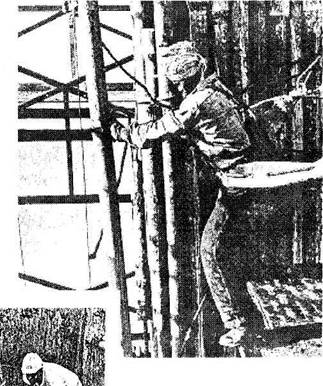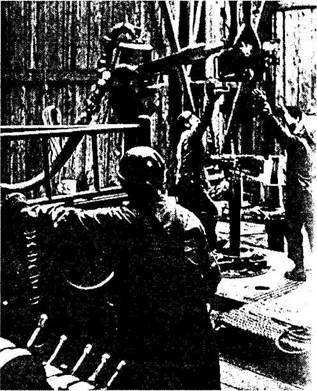Drilling for Oil Is a Difficult Job
Let's imagine that we are watching a field which a rock hound has decided may contain oil and that leases have been signed by the owner, permitting the producer to drill. One fine day we see a procession of heavy trucks churn through the mud and unload piles of lumber and steel parts, reels of cable, and everything needed by the rig builders. Before they begin this wildcat well, we ought to give it a name. Let us call the producer the Pioneer Oil Company, and the owner of 74 Chapter Three
Drilling for Oil the land Mr. Smith. By long custom the well would then be called Pioneer Smith Number One. The first step is building foundation for the derrick; heavy sills are put on concrete blocks at the corners, over a pit or cellar, six to twenty feet deep. The derrick floor, several feet above ground, rests on the sills. Next, the derrick itself goes up; it is an open tower seventy to one hundred and eighty feet high, built of timbers or steel. The crown block, a frame on which several grooved pulleys called sheaves are mounted, is right under the peak of the derrick. The reason the derrick is built so high is to make it possible to haul long strings of pipe out of the well hole. Near the derrick, which is boarded up and roofed over near the bottom to make a shed around the derrick floor, is another shed where the engine is housed. As soon as the derrick is finished, the rig builders push on to another oil field, and the drilling crew takes over. On a cable-tool job, the driller is a top man, and there is one driller in charge of each shifts He must know a dozen trades and must be able to tell by the feel what his tools are doing at the bottom of a mile-deep hole. His right hand man is the tool dresser, who helps him sharpen bits, besides performing many other duties. The tool-dresser hopes some day to become a driller himself. The rotary driller has a crew of five helpers, called cathead men, derrick men, pipe rackers, boiler men, and lead-tong men. Roustabouts are employed to fire the boilers and do common labor. Drilling crews are called roughnecks, and their field boss, in charge of several wells, is the tool pusher. Now, at last, the drilling crew has installed all the machinery and fired up the boiler to make steam for the engine. The driller lowers his bit into the ground; he gives the go-ahead signal and Pioneer Smith Number One is "spudded in". Long weeks of grind lie ahead with work going on for twenty-four hours a day. All workers must be consnantly alert to take care of any emergency before it grows serious. Everybody keeps his fingers crossed, waiting for the time when the well gets near the oil sands. This may take a long time. Now comes the critical moment! The tool pusher, the president of the company, the landowner, and the whole drilling crew all watch the wellhead tensely. Will this one hit oil or will it turn out to be just another dry hole? Suddenly there is whooshing noise at the control head, and oily spray spurts from the cracks around the pipes. All hands watch the driller open a valve very slowly. A greenish-black stream pours from the nozzle of the pipe into an empty tank. More valves are turned on, and soon the big tank is nearly full. "Looks like a 76 Chapter Three six-thousand-barrel baby", drawls the driller, trying to keep his voice calm. Pioneer Smith Number One has come in!
Putting together and setting up derricks is called to rig up. It takes men of daring. At right, two arabians balance in the air while they rig up electric cables on a new derrick in the Saudi Arabian desert. Men who help move a rig into location and off again are called roustabouts. This name should never be confused with roughnecks, the men who make up the drilling team. Oil is "where you find it." Oilmen don't choose a spot because it is easy to drill there, they go wherever there's a chance of oil underground, no matter where it may be. Here, a hand-powered rotary drill has been set up in the jungles of New Guinea. Oil companies sometimes lease (rent) land from private people, and sometimes from their own or a foreign government. If oil is found, the owner of the land and the oil companies each take an arranged share of the profit.
Drilling for Oil
Drilling crews work around the clock in 8-hour shifts, usually in the open, in rain or snow which can make the rig floor slippery. or even sometimes in the midst of blinding sandstorms. Aside from the drilling crew, there is a field boss in charge of several wells. Fie is called a tool pusher. The tool pusher has most of the resposibility lor whatever may go wrong. Here, he w ate lies a beginning operation. Starting a hole for the drilling tools r-called a spud in. These roughnecks are deepening the hole before putting in the pipe casing that will line it. Chapter Three
Men build high in order to dig deep, not only on land, but over water, too. These Venezuelan roustabouts (derrick workmen) are setting up a rig over water. The job of oil-field worker, like all jobs that risks in order to discover something new, is difficult, tough and, at times, dangerous. The Venezuelan driller at left is chief of a team of four roughnecks. A roughneck is a highly skilled workman who needs a quick hand and eye, steady nerves, physical strength, and mechanical sense, to protect life and limb. The hard hat is his badge of office, and the older and more battered it is, the better he likes it.
This is a drilling floor of a rig in Canada. Usually, three roughnecks work on the derrick floor. Here you can see the confusing arrangement of hooks, winches, chains, tongs and open gears that make up a rotary rig. On the drilling floor there is an almost unbelievable din and clanger made up of every sound from the clash of steel against steel and the roar of the spinning drill to the rattling of the derrick sides.
Drilling for Oil
Paraphrasing Material with Specialized use of Vocabulary Sometimes a particular word is used in a very special way that depends on the meaning of the entire sentence or paragraph. In the following exercise, first read the vocabulary hints. Then paraphrase (put into clear and direct words) the italicized words. 1. The usual meaning of the word hound is a dog of any of hunting 2. The two-word phrase "a right hand" is quite understandable. Usually 3. The word "baby in Paragraph 6 is quite unusual. But its meaning can
|










 After You Read
After You Read


